Yuanpu Xie
Learning to Rank For Push Notifications Using Pairwise Expected Regret
Jan 19, 2022
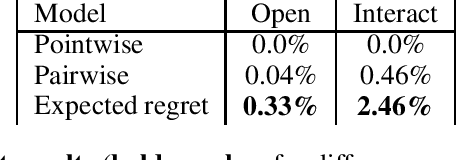
Abstract:Listwise ranking losses have been widely studied in recommender systems. However, new paradigms of content consumption present new challenges for ranking methods. In this work we contribute an analysis of learning to rank for personalized mobile push notifications and discuss the unique challenges this presents compared to traditional ranking problems. To address these challenges, we introduce a novel ranking loss based on weighting the pairwise loss between candidates by the expected regret incurred for misordering the pair. We demonstrate that the proposed method can outperform prior methods both in a simulated environment and in a production experiment on a major social network.
Model Size Reduction Using Frequency Based Double Hashing for Recommender Systems
Jul 28, 2020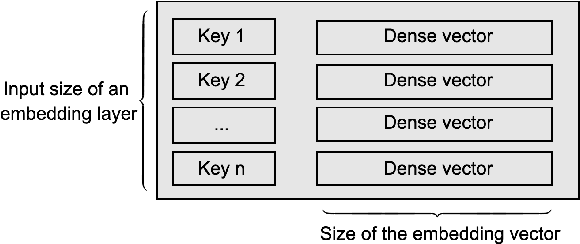



Abstract:Deep Neural Networks (DNNs) with sparse input features have been widely used in recommender systems in industry. These models have large memory requirements and need a huge amount of training data. The large model size usually entails a cost, in the range of millions of dollars, for storage and communication with the inference services. In this paper, we propose a hybrid hashing method to combine frequency hashing and double hashing techniques for model size reduction, without compromising performance. We evaluate the proposed models on two product surfaces. In both cases, experiment results demonstrated that we can reduce the model size by around 90 % while keeping the performance on par with the original baselines.
Privacy-Preserving Recommender Systems Challenge on Twitter's Home Timeline
Apr 28, 2020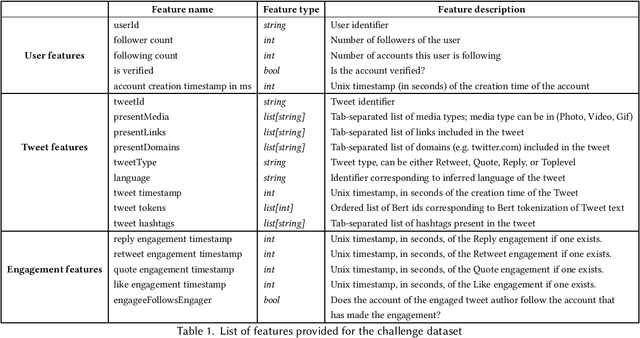
Abstract:Recommender systems constitute the core engine of most social network platforms nowadays, aiming to maximize user satisfaction along with other key business objectives. Twitter is no exception. Despite the fact that Twitter data has been extensively used to understand socioeconomic and political phenomena and user behaviour, the implicit feedback provided by users on Tweets through their engagements on the Home Timeline has only been explored to a limited extent. At the same time, there is a lack of large-scale public social network datasets that would enable the scientific community to both benchmark and build more powerful and comprehensive models that tailor content to user interests. By releasing an original dataset of 160 million Tweets along with engagement information, Twitter aims to address exactly that. During this release, special attention is drawn on maintaining compliance with existing privacy laws. Apart from user privacy, this paper touches on the key challenges faced by researchers and professionals striving to predict user engagements. It further describes the key aspects of the RecSys 2020 Challenge that was organized by ACM RecSys in partnership with Twitter using this dataset.
Photographic Text-to-Image Synthesis with a Hierarchically-nested Adversarial Network
Apr 06, 2018



Abstract:This paper presents a novel method to deal with the challenging task of generating photographic images conditioned on semantic image descriptions. Our method introduces accompanying hierarchical-nested adversarial objectives inside the network hierarchies, which regularize mid-level representations and assist generator training to capture the complex image statistics. We present an extensile single-stream generator architecture to better adapt the jointed discriminators and push generated images up to high resolutions. We adopt a multi-purpose adversarial loss to encourage more effective image and text information usage in order to improve the semantic consistency and image fidelity simultaneously. Furthermore, we introduce a new visual-semantic similarity measure to evaluate the semantic consistency of generated images. With extensive experimental validation on three public datasets, our method significantly improves previous state of the arts on all datasets over different evaluation metrics.
Improving Deep Pancreas Segmentation in CT and MRI Images via Recurrent Neural Contextual Learning and Direct Loss Function
Jul 18, 2017


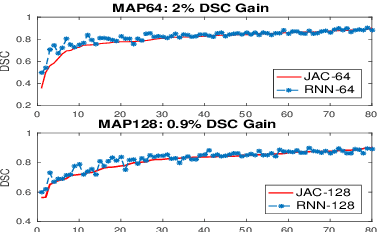
Abstract:Deep neural networks have demonstrated very promising performance on accurate segmentation of challenging organs (e.g., pancreas) in abdominal CT and MRI scans. The current deep learning approaches conduct pancreas segmentation by processing sequences of 2D image slices independently through deep, dense per-pixel masking for each image, without explicitly enforcing spatial consistency constraint on segmentation of successive slices. We propose a new convolutional/recurrent neural network architecture to address the contextual learning and segmentation consistency problem. A deep convolutional sub-network is first designed and pre-trained from scratch. The output layer of this network module is then connected to recurrent layers and can be fine-tuned for contextual learning, in an end-to-end manner. Our recurrent sub-network is a type of Long short-term memory (LSTM) network that performs segmentation on an image by integrating its neighboring slice segmentation predictions, in the form of a dependent sequence processing. Additionally, a novel segmentation-direct loss function (named Jaccard Loss) is proposed and deep networks are trained to optimize Jaccard Index (JI) directly. Extensive experiments are conducted to validate our proposed deep models, on quantitative pancreas segmentation using both CT and MRI scans. Our method outperforms the state-of-the-art work on CT [11] and MRI pancreas segmentation [1], respectively.
MDNet: A Semantically and Visually Interpretable Medical Image Diagnosis Network
Jul 08, 2017
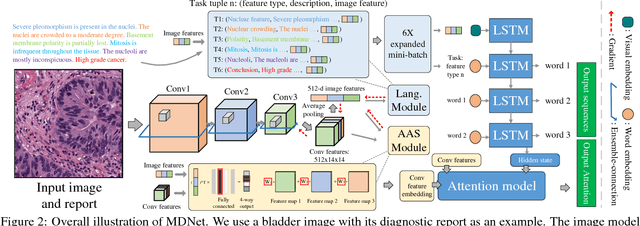


Abstract:The inability to interpret the model prediction in semantically and visually meaningful ways is a well-known shortcoming of most existing computer-aided diagnosis methods. In this paper, we propose MDNet to establish a direct multimodal mapping between medical images and diagnostic reports that can read images, generate diagnostic reports, retrieve images by symptom descriptions, and visualize attention, to provide justifications of the network diagnosis process. MDNet includes an image model and a language model. The image model is proposed to enhance multi-scale feature ensembles and utilization efficiency. The language model, integrated with our improved attention mechanism, aims to read and explore discriminative image feature descriptions from reports to learn a direct mapping from sentence words to image pixels. The overall network is trained end-to-end by using our developed optimization strategy. Based on a pathology bladder cancer images and its diagnostic reports (BCIDR) dataset, we conduct sufficient experiments to demonstrate that MDNet outperforms comparative baselines. The proposed image model obtains state-of-the-art performance on two CIFAR datasets as well.
 Add to Chrome
Add to Chrome Add to Firefox
Add to Firefox Add to Edge
Add to Edge